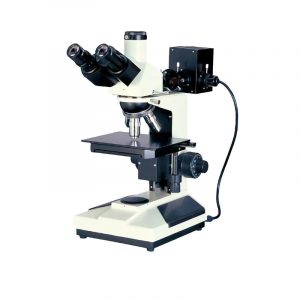金属顕微鏡: 金属の内部の秘密を明らかにするための精密ツール
金属組織顕微鏡は、金属サンプルの表面の金属組織を観察するために使用される顕微鏡の一種です。, which plays an important role in the field of materials research and engineering. この論文では, 動作原理, application field and the difference between upright and inverted metallographic microscopes are discussed in depth, and the characteristics of simple polarization are also introduced.

使い方:
The working principle of metallographic microscope is to observe the surface microstructure of metal specimen by incident illumination. Metallographic structure refers to the grain arrangement and composition structure inside a metal or alloy, which has an important influence on the properties and properties of materials. Metallographic microscopy is performed by placing the sample under a microscope, illuminating the sample with a transmitted light source, and observing the microstructure of the sample surface through an optical system. This technique allows researchers to observe the microstructure of metal samples in detail, including grain size, 分布, オリエンテーション, and phase content.
金属顕微鏡: 金属の内部の秘密を明らかにするための精密ツール
pplication field:
Metallographic microscopes are widely used in a number of fields, including but not limited to:
冶金
It is used to analyze the grain structure of metal materials to optimize the heat treatment and processing of materials.
cast
Helps to evaluate the quality of castings, detect defects and tissue heterogeneity.
Quality inspection
It is used to check the material quality of manufactured parts and products to ensure that they comply with standards.
Schools and Laboratories
Used in education and research to help students and researchers understand the microstructure of metal materials.
Industrial and mining enterprises
For materials research and engineering applications to improve product performance and material selection.
金属顕微鏡: 金属の内部の秘密を明らかにするための精密ツール
Upright and inverted:
Upright and inverted metallographic microscopes are two different types of metallographic microscopes, and they have some differences when looking at samples:
Orthographic microscope: The optical path of orthographic microscope is straight, and the sample is placed on the stage, which is suitable for observing the surface of the metallographic structure. This type of microscope is often used for tissue observation on the surface of a material.
Inverted metallographic microscope: The optical path of the inverted metallographic microscope is inverted, and the sample is placed under the carrier. This type of microscope is suitable for viewing samples immersed in liquids, such as metal samples in corrosive fluids, or for viewing biological samples.
金属顕微鏡: 金属の内部の秘密を明らかにするための精密ツール
With simple polarization:
Many metallographic microscopes are also equipped with a simple polarizing device, which allows researchers to observe the polarizing light properties of the sample. Polarizing microscopy can help to analyze grain orientation, residual stress and tissue heterogeneity in materials. This is important for materials research and quality control because it provides important information about the properties and behavior of materials.
要約すれば, the metallographic microscope is an elusive or missing tool in the field of materials research and engineering, which helps scientists to deeply study the microstructure of metal materials and provides important data for optimizing material properties and quality. The upright and inverted metallographic microscopes and the simple polarizing function make them suitable for different types of samples and observation tasks, supporting a wide range of applications. The metallographic microscope, like a window that opens the secret door inside the metal, reveals to us the infinite possibilities in the world of materials.
